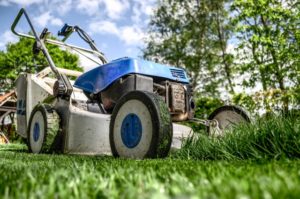How to Make a Succulent Terrarium in Minutes

This is a guest post written by Kylie from grohelps.
When it comes to potentially making a succulent terrarium, then there are a number of key points to keep in mind so that you end up with something that you can then be proud of. However, if you believe that this is going to be something that is too difficult for you to do, then you may be pleasantly surprised. Instead, with some basic knowledge you can set up your own terrarium at home and then be quite content with the end result.
1. The Things You Need.
 Let us begin by looking at the things you are going to need in order to set this up all on your own. The list is not exactly extensive by any means and nor is it going to cost you a small fortune to get things up and running. So, if you are interested in this type of growing, then these are the main ‘ingredients’ that you are going to require in order to get started.
Let us begin by looking at the things you are going to need in order to set this up all on your own. The list is not exactly extensive by any means and nor is it going to cost you a small fortune to get things up and running. So, if you are interested in this type of growing, then these are the main ‘ingredients’ that you are going to require in order to get started.
- Some kind of glass vessel that also has a wide enough opening.
- Some activated charcoal that has to be applied later on.
- Some soil that is specifically for succulents.
- A spoon.
- Some tweezers.
- A chopstick will also be rather useful.
- A range of succulents.
- Some decorative stones.
- A misting bottle.
2. Making Sure the Glass is Clean
 One of the most important things that you are going to need in this situation is to check that the glass is clean before you start. Now, you might think that this is just so obvious that it is difficult to understand how anybody could fail to do it, but there is a bit more to it than you would have perhaps previously imagined.
One of the most important things that you are going to need in this situation is to check that the glass is clean before you start. Now, you might think that this is just so obvious that it is difficult to understand how anybody could fail to do it, but there is a bit more to it than you would have perhaps previously imagined.
Cleaning the glass before you go ahead and start planting things makes so much sense as you hardly want all of those chemicals mixing in with the plants and it certainly gets harder to clean it all later on. However, making sure that it is sparkling is not that difficult as we can see.
- Polish the glass in advance and check for any marks.
- Look at it from various angles and remove any kind of grime you may see.
- Do not cover it in chemicals unless you clean them off thoroughly.
- Clean glass makes the finished result look so much better.
3. Make Sure You Add Drainage Layers
 When growing any plants it is important that you understand the role that good drainage plays in their potential development and growing plants in this kind of environment is no different. However, as you are dealing with a slightly different container it is important that you go about it the correct way and the method that is used by almost everybody is to use drainage layers.
When growing any plants it is important that you understand the role that good drainage plays in their potential development and growing plants in this kind of environment is no different. However, as you are dealing with a slightly different container it is important that you go about it the correct way and the method that is used by almost everybody is to use drainage layers.
So, you are perhaps unaware of what they are and how to do them, but it is actually a lot easier than you were perhaps fearing. Drainage layers help the water to move away from the roots rather than having them standing in water which then leads to root rot. In this situation, you need to do the following for it to work correctly.
- Use small decorative pebbles and place them at the bottom of the glass vessel.
- Make sure that they are only slightly larger than sand.
- Make sure that they cover a reasonable depth although this depends on the vessel.
- There is no need to press the pebbles down.
4. Make Sure You Add Your Activated Charcoal
 At this point, we have to discuss the need for you to add the activated charcoal as this is going to play a very specific role in the development of the terrarium and the environment that you are trying to create. Now, once again there is no need for you to get stressed out about this charcoal as it plays a very specific role.
At this point, we have to discuss the need for you to add the activated charcoal as this is going to play a very specific role in the development of the terrarium and the environment that you are trying to create. Now, once again there is no need for you to get stressed out about this charcoal as it plays a very specific role.
- The charcoal stops the build-up of micro-organisms.
- It also helps with the drainage.
- You need around one inch of activated charcoal in the base.
- It also helps the air to remain clean.
5. Get the Soil
 So, now that you have effectively prepared the terrarium you are then ready to take it to the next level and that involves you adding the soil. Now, considering the plants that you are using it is important that the soil has excellent drainage as none of these plants enjoy having their feet wet at any point. In actual fact, you might have to add some vermiculite or even some sand to help with the drainage or look for specialist soil for this kind of growing.
So, now that you have effectively prepared the terrarium you are then ready to take it to the next level and that involves you adding the soil. Now, considering the plants that you are using it is important that the soil has excellent drainage as none of these plants enjoy having their feet wet at any point. In actual fact, you might have to add some vermiculite or even some sand to help with the drainage or look for specialist soil for this kind of growing.
- Always make sure that you use specialist soil.
- It has to be very well draining.
- You might want to add some sand or vermiculite.
- If you are new to it, then only use succulent soil.
6. Lay Out the Arrangement
Once you have added the soil, you then need to think about how you are going to arrange the different plants as there is more to it than just throwing them in and hoping that it somehow all comes together. Instead, you need to take some real care with the arrangement or else the entire thing just looks like a mess and is not that pleasing on the eye.
- Look at the range of plants that you plan on using.
- Remember the size and spacing that they need.
- Also remember that different plants have different light needs.
- Position them, but do not plant them at this point.
- Look at it, think about it, then prepare to plant them when you are content.
[7. Plant Your Succulents
Once you are quite content with the arrangement, it is then time to plant the different succulents and that is perhaps the easiest part of this entire process. However, you do need to be quite methodical about it all so that you work through the plants in an easy to follow manner as it just removes some of the stress of the planting out and you will stand a better chance of doing everything in the correct manner.
- Add your plants to the soil and press them down to help the roots bind.
- Work by planting them in an easy to follow manner.
- Double check that you are content with the placement.
8. Be Careful with the Water
We now have to look at the water situation because you cannot just throw lots of water in and hope for the best. Instead, there is a very real need for you to be careful and water these plants in the correct manner or else you are going to increase the chances of there being all kinds of diseases and issues.
- Succulents do not need a lot of water.
- However, you need to water the plants after planting them.
- Do not over saturate them or the plants will rot.
- They only need some water sporadically.
9. Clean it Up and Decorate
At the point of having planted everything out, you then just have to think about the decoration aspect and cleaning everything up. This kind of arrangement should always be pleasant to the eye so you hardly want things to look a mess. You have a number of different options available to you when it comes to decorating them. Indeed, different people with terrariums will use pebbles of various sizes or colors including different sand. You can also use quartz or even crystals if you want to be different.
- Use decorative pebbles or even colored sand.
- Spread them around the plants to make it look more pleasing to the eye.
- Experiment with colors and mix them together.
10. Enjoy it
Finally, just enjoy your terrarium because it is going to bring you a lot of pleasure as you watch the plants become established and then grow. This is all about having different plants in a different growing environment and seeing what you can make of it. The best part is that it does not take a lot of care for it to develop and that does save you a lot of hard work in the process.
- Succulents in a terrarium require little upkeep.
- They require little watering or fertilizing to keep them going.
- Make sure they have adequate light.
- Keep an eye out for any disease or problems with the plants and remove them immediately.
So, those are ten different important points for you to keep in mind if you are planning on having your own succulent terrarium. As you can see, we are not talking about anything that is too complex at any point so there is nothing to fear even if you are indeed completely new to this particular form of gardening. Remember, this is all about experimenting and there is effectively no wrong way of doing things just as long as you take care of the different plants.






